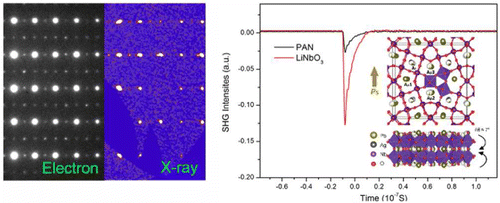
The incorporation of transition metal element Ag was performed to explore negative thermal expansion (NTE) materials with tetragonal tungsten bronze (TTB) structures. In this study, the structure and thermal expansion behaviors of a polar TTB oxide, Pb2AgNb5O15 (PAN), were systematically investigated by high-resolution synchrotron powder diffraction, high-resolution neutron powder diffraction, transmission electron microscope (TEM), and high-temperature X-ray diffractions. The TEM and Rietveld refinements revealed that the compound PAN displays (√2aTTB, √2bTTB, 2cTTB)-type superstructure. This superstructure within the a–b plane is caused by the ordering of A-site cations, while the doubling of the c axis is mainly induced by a slight tilt distortion of the NbO6 octahedra. The transition metal Ag has larger spontaneous polarization displacements than Pb, but the Pb–O covalence seems to be weakened compared to the potassium counterpart Pb2KNb5O15 (PKN), which may account for the similar Curie temperature and uniaxial NTE behavior for PAN and PKN. Powder second harmonic generation (SHG) measurement indicates that PAN displays a moderate SHG response of ∼0.2 × LiNbO3 (or ∼100 × α-SiO2) under 1064 nm laser radiation. The magnitudes of the local dipole moments in NbO6 and PbOx polyhedra were quantified using bond-valence approach. We show that the SHG response stems from the superposition of dipole moments of both the PbOx and NbO6 polyhedra. Inorganic Chemistry, 2016 |

